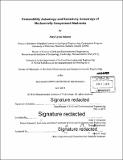Permeability anisotropy and resistivity anisotropy of mechanically compressed mudrocks
Author(s)
Adams, Amy Lynn
DownloadFull printable version (61.00Mb)
Other Contributors
Massachusetts Institute of Technology. Department of Civil and Environmental Engineering.
Advisor
John T. Germaine.
Terms of use
Metadata
Show full item recordAbstract
Permeability anisotropy (the ratio of the horizontal to vertical permeability) is an important parameter used in sedimentary basin models and geotechnical design to model fluid flow, locate hydrocarbon reserves and estimate stress and pressure evolution. The magnitude of the permeability anisotropy for a given mudrock is difficult to measure; further, whether the permeability anisotropy is a constant value or evolves with the basin state is of active debate. This thesis experimentally investigates the development of permeability anisotropy in mechanically compressed mudrocks. A novel measurement method is developed using resedimented cubic specimens. The permeability anisotropy of Resedimented Boston Blue Clay (RBBC) is systematically measured to determine both the magnitude and evolution of the permeability anisotropy. The permeability anisotropy predicted using measurements of the mudrock fabric is compared with the measured permeability anisotropy to understand the relationship between fabric evolution and permeability anisotropy. Finally, resistivity anisotropy is compared with permeability anisotropy to reveal useful field correlations. The results of the RBBC study are contrasted with additional measurements made using mudrocks covering a range of plasticity, clay fraction and mineralogical composition. The permeability anisotropy and the conductivity anisotropy (inverse of the resistivity anisotropy) of uniform RBBC increase from 1.2 to 1.9 as the porosity decreases from 0.49 to 0.36. The permeability decreases by over one order of magnitude and the formation factor triples over this porosity range. Platy particles rotate from ~ 42 to 28 degrees to the horizontal, driving permeability anisotropy development. Further decreasing the porosity of RBBC below porosity 0.36 decreases both the permeability anisotropy and the conductivity anisotropy. Finally, the conductivity anisotropy is shown to equal to the permeability anisotropy within +/-20%. This general behaviour is characteristic of all mudrocks studied. Though small (<2), the permeability anisotropy of uniform mudrocks can significantly increase the permeability anisotropy of larger systems, as shown through layered system models. These models also reveal that the large scale conductivity anisotropy is not equal to the permeability anisotropy, though the relationship identified for uniform mudrocks may still be useful for sites with high measurement resolution.
Description
Thesis: Ph. D. in Geotechnical and Geoenvironmental Engineering, Massachusetts Institute of Technology, Department of Civil and Environmental Engineering, 2014. Cataloged from PDF version of thesis. Includes bibliographical references (pages 313-322).
Date issued
2014Department
Massachusetts Institute of Technology. Department of Civil and Environmental EngineeringPublisher
Massachusetts Institute of Technology
Keywords
Civil and Environmental Engineering.
